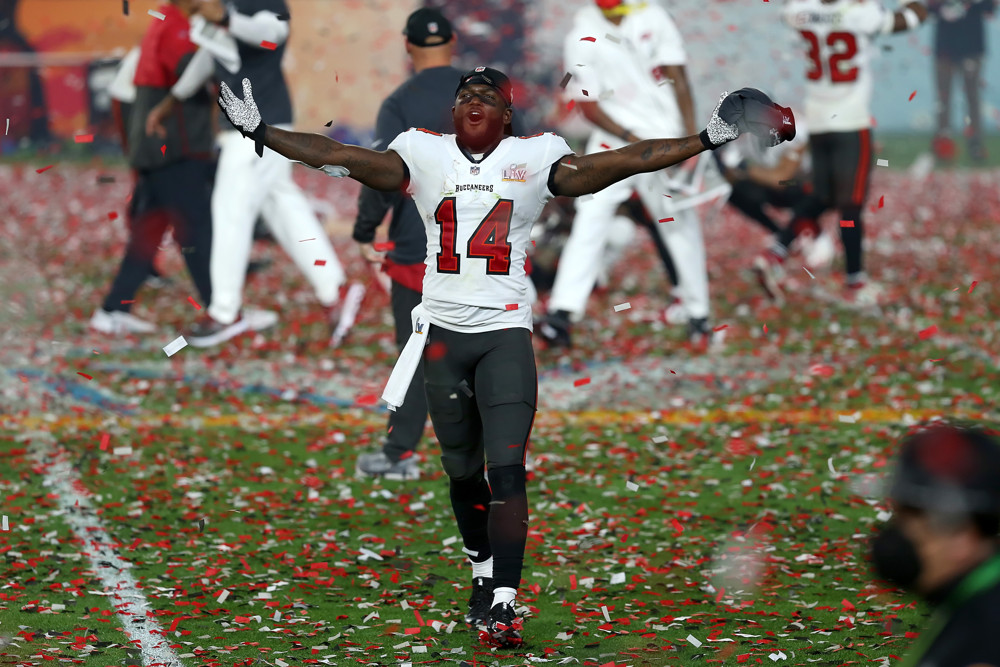You want to win $1 million playing fantasy football? Join the club.
DraftKings’ weekly NFL Milly Maker remains the flagship DFS tournament. It’s a unique event because it often has more than 200,000 entries, roughly 30% of the prize pool goes to first place and someone becomes a millionaire off a $20 buy-in.
This “put up a little to win a lot” model is always going to be incredibly popular. It attracts tons of unsophisticated and casual players, making the Milly Maker a very +EV tournament for thoughtful and sharp players. Of course, we need to be aware that realizing the positive expectation is very difficult at these massive field sizes.
So how do we win it? By picking the right players, dummy! Of course, that is first-level thinking and not a real or thoughtful strategy. We are not nearly as good at picking the “right” players as we think we are. So while much of the field is just selecting players they like, we need to optimize for first place through other strategies.
That means thinking about lineup construction, salary allocation, flex usage, correlation, ownership leverage and more. If we can understand what wins this tournament, we can build a repeatable process that raises our chances of shipping.
The data you see below was compiled by Mike Leone, our Director of Analytics.
* Note — this data is from the Top 100 teams in main slate DraftKings Milly Makers in 2021 Weeks 1-16. That’s 1630 teams, including ties.
WHAT WE FOUND
1. Double Stack Our Quarterback
“Double stack” means rostering a QB with exactly two of his teammates at any position. For example, Dak Prescott with Amari Cooper and Ezekiel Elliott. Or Dak with Cooper and CeeDee Lamb. Or Dak with Lamb and Michael Gallup. The field has raised their double-stack percentage over the last few years, but they are still lagging far behind the winning teams.
Note that single stacks provided no leverage (field 46.6%, Top 100 teams 47.0%). And triple stacks had poor results (field 3.4%, Top 100 teams 2.5%).
Data: The field played double stacks 28.6% of the time. But double stacks finished in the Top 100 39.5% of the time. Note that this is the same conclusion we found in 2017-19 data — double stacking creates the best leverage on the field.
2. Bring It Back With One Opponent — Specifically a Wide Receiver
“Bring it back” means using at least one player from the opponent of our quarterback stack. For example, if the Cowboys are playing the Eagles our stack could be Dak Prescott, Amari Cooper and Michael Gallup. Our ideal bring back would be one of Devonta Smith or Jalen Reagor. The idea is to maximize correlation and decrease the number of things we need to get right. If Dak has a monster game, chances are his teammates went off and someone on the other side was forcing him toward the ceiling of his attempt range.
Data: The field brought it back with one opponent 34.6% of the time. But single bring backs finished in the Top 100 52.5% of the time. Note that the best leverage was at WR, where the field brought it back with one WR at 25.5% but Top 100 teams were at 48%.
3. Spend All or Most of our Salary Cap
There’s a narrative out there which suggests leaving cap money on the table is sharp because you’re more likely to have a unique team. While that’s true on Showdown and shorter slates, it’s simply not a factor in the Milly Maker. These are 12- and 13-game slates with an endless number of combos. For the fourth straight year, we found zero edge in leaving money on the table. If anything, spending more showed a slight advantage — simply because we’re making better projected teams.
Data: The field used the entire $50,000 cap 48.6% of the time. Top 100 teams used the full cap 51.7% of the time. The margins were similar at $49,900 (23.3% vs. 24.0%) and $49,800 (11.6% vs. 11.1%).
4. Use Wide Receiver In Flex Spot
There was a time when rostering three RBs and three WRs aka “RB in the flex” was standard practice among sharps. That has changed, in part because DraftKings raised the salary floor at RB to $4,000. As of last season, our best leverage came with a two RB, four WR lineup — aka WR in the flex. That could be slightly skewed by injuries to Christian McCaffrey and Saquon Barkley last season, but I expect the overall trend to continue.
At the core, WR in the flex is correct because their top 1% outcomes are higher than running backs in this full-PPR format. But there are ancillary benefits as well. It gives us more room to Double Stack WRs (see No. 1 above). It gives us more room to bring it back with a WR (see No. 2 above). And finally, it’s easier to find leverage plays at WR — guys who have a good ceiling with lower ownership than a RB.
Data: The field used WR in the flex 45.1% of the time. Top 100 teams used WR in the flex 56.4% of the time. Both RB (42.7% field vs. 35.4% Top 100) and TE (12.2% field vs. 8.2% Top 100) flex usage had negative leverage.
5. Spend Up At Quarterback
This is the biggest shift we’ve seen in DFS over the last year. The emergence of multiple elite dual-threat QBs has changed the entire landscape. Josh Allen, Kyler Murray, Lamar Jackson, Deshaun Watson, Russ Wilson, Patrick Mahomes — it is simply very difficult for pure pocket passers (even in good matchups) to match the consistency and ceiling. This season, we’ll add in more strong rushers such as Trey Lance and Justin Fields. We need to find upside at the QB position — we can’t just skate by anymore with matchups and floors. Note that this year, we are adding ceiling to our projection tables.
So where did the money come from to spend at QB? Both the field and Top 100 teams are spending less at running back — roughly $5,750 on average.
Data: The field’s QB averaged $6,568 in salary. The Top 100 teams’ QB averaged $6,825. Note that $6,825 number is roughly $800 higher than in 2017-19. Also, the field spent $7,000 or more at QB 31.4% of the time but Top 100s spent $7,000 or more at QB 49.6% of the time.
6. Stay between 75% and 125% Cumulative Ownership
Cumulative ownership simply means adding up the ownership percentage of each player in a roster. The field is going too contrarian — they were under 75% cumulative ownership 11.0% of the time. Meanwhile, Top 100 teams were under 75% cumulative ownership just 6.3% of the time.
Of course, the field is also playing teams that are too chalky — they were over 125% cumulative ownership 37.5% of the time. Meanwhile Top 100 teams were over 125% cumulative ownership 31.4% of the time.
Data: The field was between 75% and 125% cumulative ownership 53.2% of the time. The Top 100 teams were between 75% and 125% cumulative ownership 62.2% of the time.
7. It’s OK To Roster High-Owned Players Up To 40%
It’s better to roster two 30% owned players and two 2% owned players vs. four 16% owned players. In other words, a “barbell” construction. It’s worth noting that the field averaged 2.06 sub-5% owned players per lineup, but Top 100 teams only played 1.74 sub-5% owned.
On the other end of the spectrum, we want to avoid the absolute mega-chalk. The field averaged 0.25 players at 40% ownership or more, but Top 100 teams averaged just 0.13 players.
Data: The field averaged 0.29 players between 30-39%. Top 100 teams averaged 0.34 players between 30-39%. As long as we are keeping our cumulative ownership below 125% and also understanding the barbell theory, we are free to roster higher-owned players.
8. Be Willing To Spend Down At Defense
Here are the correlations between DraftKings salary and actual fantasy points:
QB: .556
RB: .479
WR: .462
TE: .409
D/ST: .232
Here are the correlations between Milly Maker ownership and DraftKings points:
QB: .506
WR: .479
RB: .463
TE: .395
D/ST: .250
And here is the correlation between our ETR projections and points (shout out to us):
QB: .667
RB: .642
WR: .575
TE: .527
D/ST: N/A, data error
Note that the correlation between ownership and DraftKings points at D/ST is just 0.250 — by far the weakest at any position. In other words, it is very hard to project how defenses will perform. As you can see above, we should be willing to both spend down in terms of salary and ownership.
Data: The field played a defense under $2,500 22.2% of the time. The Top 100 teams did it 27.6% of the time.



